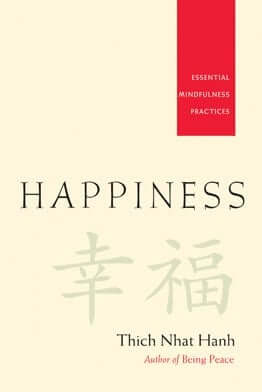
Happiness
Essential Mindfulness Practices
By Thich Nhat Hanh
Parallax Press, 2009
Softcover, 160 pages
Reviewed by Janelle Combelic
This book is a treasure trove of practical wisdom for longtime practitioners, beginners, anyone who is curious about the practice of mindfulness. Happiness summarizes in concise, clear chapters what Thay has been teaching for the last sixty years.

Happiness
Essential Mindfulness Practices
By Thich Nhat Hanh
Parallax Press, 2009
Softcover, 160 pages
Reviewed by Janelle Combelic
This book is a treasure trove of practical wisdom for longtime practitioners, beginners, anyone who is curious about the practice of mindfulness. Happiness summarizes in concise, clear chapters what Thay has been teaching for the last sixty years.
It also answers, for me, the question of what the word “practice” means in our tradition. Several years ago, twenty or so lay people gathered at Plum Village to consider the idea of a lay community. It soon became clear that people had vastly different meanings when they spoke of “practice.” Some meant formal sitting meditation, chanting, reciting sutras. And while those activities can enhance our experience of the Dharma, they are not the essence of our daily practice. “Mindfulness,” writes Thay in the introduction, “is the energy of being aware and awake to the present. It is the continuous practice of touching life deeply in every moment.... The practice of stopping is crucial. How do we stop? We stop by means of our in-breath, our out-breath, and our step. If you master these practices, then you can practice mindful eating, mindful drinking, mindful cooking, mindful driving, and so on, and you are always in the here and the now.”
The book is divided into six sections; each short chapter is a gem. “Daily Practices” covers the basics, such as breathing, sitting and walking meditation, bowing, gathas, and the Five Mindfulness Trainings. “Eating Practices” and “Physical Practices” are guidelines for caring for body and soul. The section on “Relationship and Community Practices” describes how to start and maintain a Sangha. It also offers techniques for creating healthy relationships, such as beginning anew, hugging meditation, deep listening, and loving speech. Several pages are devoted to anger and other strong emotions.
Some “Exended Practices” include solitude and silence, as well as lazy day, touching the earth, metta/love meditation, and the Fourteen Mindfulness Trainings. The section on “Practicing with Children” contains many useful tips for parents and teachers: listening to young people, walking meditation with children, the breathing room, and so on.
These are familiar teachings from Thich Nhat Hanh, which many of us have heard in Dharma talks or read in other books. But that doesn’t mean we don’t need to read them again and again, because we might need to be reminded to actually practice them. And they really do work! I can vouch for that. Even practicing as unskillfully as I have, has made a huge difference in my life. In the six years since I committed myself wholeheartedly to Thay’s tradition, I have experienced deep healing and transformation. I am far happier than ever before.
Happiness is aptly titled. “We have a rich inheritance, but we don’t know it,” writes Thay at the end of the book. “We behave as if we were poor; a destitute son or daughter. Instead we can recognize that we have a treasure of enlightenment, understanding, love, and joy inside us. It’s time to go back to receive our inheritance. These practices can help us claim it.”

Savor
Mindful Eating, Mindful Life
By Thich Nhat Hanh and Lilian Cheung
HarperOne, March 2010
Hardback, 256 pages
Reviewed by Sister Chau Nghiem (Sister Jewel)
Two out of three people in the United States are overweight and one in three is obese. Obesity is becoming a pandemic around the globe. Most methods of weight loss focus on the symptoms, not the root of the problem, which lies not only in our way of thinking and living as individuals, but very much in the increasingly unhealthy and toxic societies in which we live, which encourage us to eat more, to eat foods that undermine our health, and to move less.
Based on both the profound Buddhist wisdom of mindfulness as well as the latest science on nutrition, this book by Thich Nhat Hanh and Dr. Lilian Cheung offers a new and penetrating perspective on how we arrived at our current weight problem and what we can do to reverse it, individually and collectively. The authors gracefully apply the teachings on the Four Noble Truths, the Four Foundations of Mindfulness, the Four Nutriments, and other key Buddhist teachings to help readers understand and transform the suffering of excess weight and obesity.
Thich Nhat Hanh and Dr. Lilian Cheung, of the Harvard School of Public Health, compassionately and engagingly encourage readers to have faith in their ability to change and improve their life situation, no matter what difficulties they may have had in the past around weight loss. With the latest data on the health and environmental benefits of a more plant-based diet, meditative verses that help us incorporate mindfulness in all our activities, detailed guidelines for creating and implementing a mindful living plan that incorporates weekly goals for eating, exercising, and living more mindfully, and inspiring stories and suggestions for social activism, the book is packed with a wealth of resources for how to begin to make significant and lasting changes in our weight, in our life, and in the world, starting now.

Failsafe
Saving the Earth from Ourselves
By Ian Prattis
Manor House Publishing, 2008
Paperback, 192 pages
Reviewed by Christopher Titmuss (excerpted with permission from www.resurgence.org)
Ian Prattis, a former professor of Anthropology and Religion at Carleton University, Canada, belongs to a growing school of thought that believes humanity requires a real shift in consciousness to handle the global crises—environmental, political, and economic. A core tenet of Failsafe: Saving the Earth from Ourselves is the simple maxim that our thinking has to change if the current worldview is to change.
Under the guidance of the teachings of Thich Nhat Hanh, Prattis states that the three poisons of the mind (to quote the Buddha) have become institutionalized. Greed pervades the corporate world. Hate pervades the military. Delusion pervades advertising. The poisoning of land, water, and air, and the catastrophes for the world’s poor and marginalized have their origins in the state of mind of those who run our institutions and their intentions to make profit, act violently upon people and the earth, and manipulate the public mind. There are signs of soul-searching in our major institutions, but the pace is painfully slow.
Sai Baba, a controversial Indian guru, told Prattis that only two percent of the global population needs to meditate on a daily basis to transform human consciousness. Prattis endorses such a view and encourages people to slow down their relentless “doing” in order to experience a sense of “being”: a slowing down of thought, making it possible for fresh ways of thinking to emerge.
The book serves as a valuable collection of reflections on global issues and the part each one of us can play in making the necessary changes. While drawing on the wisdom of various authorities, past and present, Failsafe reminds us of the Buddha’s recipe for global ills—namely mindfulness, letting go, reflection, inner change, watching desire, inter-connection, and the transformation of consciousness.
Prattis writes that he remains “confident and optimistic about making the world a better place environmentally.” He has usefully employed his own experiences, the wise voices of others, and practical advice to address concerns about life on Earth. Failsafe concludes with a list of useful websites that inform and inspire further exploration.

Touch the Earth
By Joe Reilly
CD, 40 minutes
Reviewed by Nicole Brossman
Touch the Earth showcases true genre diversity, taking listeners through an intriguing landscape of rock, hip-hop, country, eco-rock, and meditative balladry. Reilly’s honest voice and consistent message have the unique ability to pull the eclectic mix together. With his Native American heritage, roots and upbringing in contemporary Catholic folk music, ever-deepening understanding of life through Buddhist meditation practice, and academic studies in environmental justice and racism, Joe Reilly is able to unite people across diverse lines of race, class, gender, age, religion, ability, and musical genre.
While listening to Touch the Earth, listeners are able to engage in lyrical discussions of ecological cycles, meditation, global warming, war, and spirituality with an open mind. Reilly’s music strengthens community while embracing diversity, inspiring listeners to experience the interconnection with one another and their environment, and inviting them to look deeper and connect with the positive aspects in their own nature. This is exemplified when he asks, in the title song, “Where’s the Earth?,” then answers, “in your hands, underneath your feet right where you stand.... It’s what you eat. Take off your shoes and socks and sink your feet in the mud of the Earth, it’s the blood of your birth.”
Reilly is a practitioner in the Plum Village tradition, and practices with the Huron River Sangha in Ann Arbor, Michigan. He also practices at Deer Park Monastery, where he received the Five Mindfulness Trainings in 2004, with the Dharma name True Faith of the Heart. He has visited Plum Village twice, and wrote many of the songs on Touch the Earth while he was there. It’s clear from the first track of the album, when Reilly sings “Keep it E-A-S-Y,” that his songwriting invites listeners to smile, laugh, and sing along with him. Reilly’s creativity brings both humor and depth to things that seem very ordinary. Through his songs we learn that a tree, a tomato, a guitar, and a human being are not separate and isolated.



